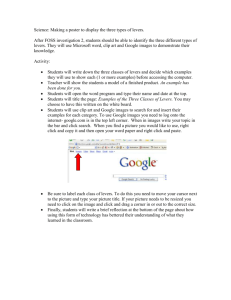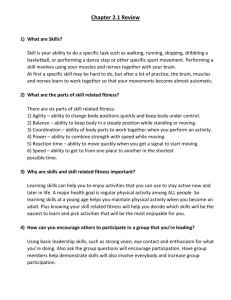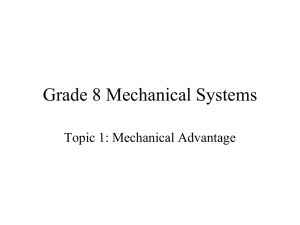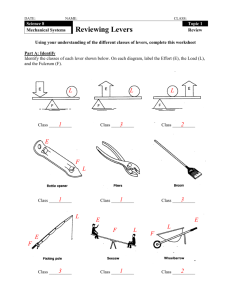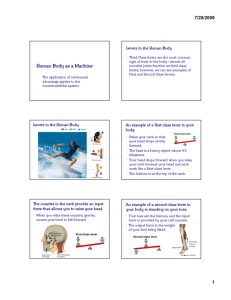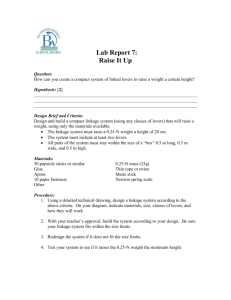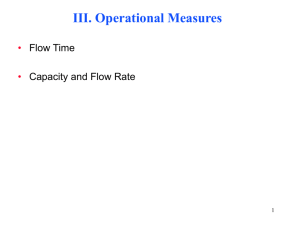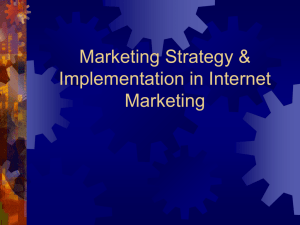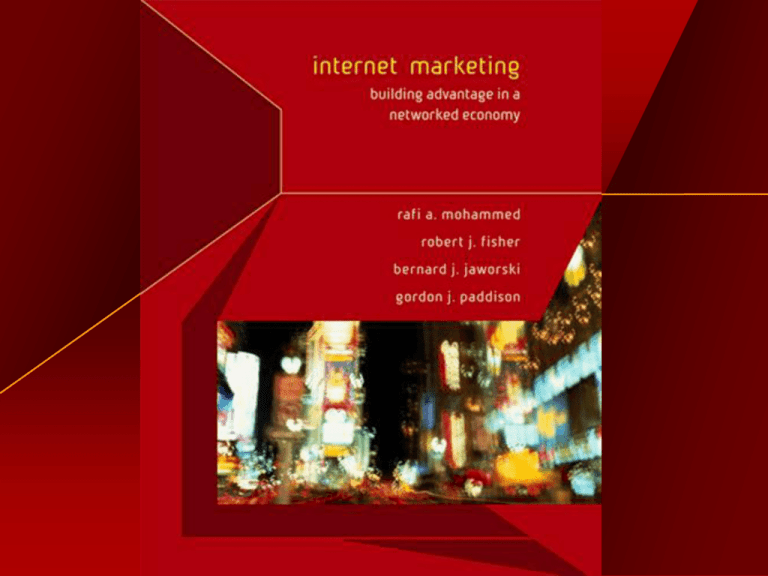
chapter
9
Communication
McGraw-Hill/Irwin
© 2004 The McGraw-Hill Companies, Inc., All Rights Reserved.
Communication — Today’s
Objectives
Objectives will be to:
Explore how the Internet affects marketing communications
Examine the marketing levers — offline and online
Discuss the six steps of the communication process
Explore integrated implementation of levers across the four
relationship stages
Chapter 9: Communication
How the Internet Affects Marketing Communications
The Marketing Levers — Offline and Online
The Six Steps of the Communication Process
Integrated Implementation of Levers Across the Four Relationship
Stages
EBay Example
Conclusion
Chapter 9: Communication
How the Internet Affects Marketing Communications
The Marketing Levers — Offline and Online
The Six Steps of the Communication Process
Integrated Implementation of Levers Across the Four Relationship
Stages
EBay Example
Conclusion
Exhibit 9.1: The Effects of the 2Is on
Communication
Individualization
Interactivity
Individual controls
information flow
Allows consumers to
specify preferences
Allows more targeted
communications
Individualized
marketing
communications are
more relevant to the
consumer
Facilitates relationship
building through twoway communication
Allows tracking of
consumer response to
marketing
communications
Communication
Personalization and Predicting
Behavior
Point-Counterpoint
Prediction Based on
Past Behavior Is Effective
Past behavior is predictive of
preferences and current behavior
People who buy products of type x
will be interested in products similar
to type x
Not only is this an effective way to
determine consumer preferences, it
is also simple to track
Past Behavior Is Not a
Good Predictor
Purchase behavior is driven by
goals, not past behavior
Personal goals constantly change
and past behavior does not provide
much insight into these goals
Purchases such as gifts and
infrequently purchased products like
a TV set are examples of instances
where past behavior is ineffective
Exhibit 9.2: The 2Is Streamline
Advancement Through the Stages
One Seamless Experience
2Is
Banner Ad
(to promote
awareness)
2Is
Website
User can set up the webpage
according to personal preferences,
register for e-mails, give feedback,
or make a purchase
User clicks on banner
to find out more
Awareness
Personalized
Website
Permission emails
Individualized
offerings
Exploration
Commitment
Chapter 9: Communication
How the Internet Affects Marketing Communications
The Marketing Levers — Offline and Online
The Six Steps of the Communication Process
Integrated Implementation of Levers Across the Four Relationship
Stages
EBay Example
Conclusion
Exhibit 9.3: Online and Offline
Levers
Offline
Outdoor
Advertising
(Billboards)
Radio
Yellow
Pages
Sales
force/Faceto-Face
Public
Relations
Televisio
n
Telemarketing
Brochure
s
Newsletter
s
Magazine
s
Newspapers
Direct
Mailings
Point-ofPurchase
Displays
Sponsorship
s
Customer
Service
Online
Banner Ads
Websites
Rich
Media
Interstitial
s
Dynamic
Ads
Classifieds
& Listings
Search
Engines
Mass
Personal
Websites
Interactiv
e
Television
Personal
Wireless
Devices
E-Mail
Marketing
Exhibit 9.4: Profiles of Online Media
Types
Medium
Advantages
Disadvantages
Websites/Personalized
websites
Communicate rich, detailed information that users
can navigate at will; can track users and customize
site accordingly.
Narrow reach
Banner ads
Link directly to buying opportunity; easy to measure
effectiveness; wide reach; potential for effective
targeting
Low attention and click-through rates; short life;
limited “pass-along” audience; very high clutter;
fleeting exposure
Interstitials
Catch users’ attention; link to buying opportunity
Can annoy users; limited “pass-along” audience
Rich media
Attention-getting; link to buying opportunity
Can annoy users without broadband access
Dynamic ad placement
Serves up customized ads to users in real time
Difficult to execute well; can annoy users, other
advertisers
Search engines
Good credibility; high believability; guarantee of
position available; significant audience at major sites
High competition; information overload; limited
“pass-along”
Classifieds and
listings
Relatively inexpensive, potential for wide exposure;
qualified audience
Clutter
Opt-in e-mail
High demographic selectivity; high credibility;
significant flexibility; proven high click-through rates;
absolutely inexpensive; some pass-along
Requires substantial user base before effective;
high clutter
Mass e-mail
High reach; inexpensive; flexible
Low attention and significant resentment (spam
image)
Customer service
Interested parties asking for help, thus high targeting
value; generates loyal customers
Very expensive to provide comprehensive
telephone, e-mail, and online support
Exhibit 9.5: Internet Ad Terms
Ad Clicks
Aggregate number of user clicks on a banner ad
Ad Views
(Impressions)
Number of times a banner ad is downloaded to a user’s browser and presumably looked at
Click-Through
Percentage of ad views that are clicked upon; also “Ad Click Rate”
CPC
(Cost-per-Click)
Formula used to calculate what an advertiser will pay to an Internet publisher based on
number of click-throughs a banner generates
Cost per thousand impressions of a banner ad; a publisher that charges $10,000 per
banner and guarantees 500,000 impressions has a CPM of $20 ($10,000 divided by 500)
Measurement recorded in server log files that represent each file downloaded to a
browser; since page design can include multiple files, hits are not a good guide for
measuring traffic at a website
Number of individuals who visit a website in a specified period of time; requires the use of
registration or cookies to verify and identify unique users
A series of requests made by an individual at one site; if no information is requested for a
certain period of time, a “time-out” occurs and the next request made counts as a new visit
— a 30 minute time-out is now standard
CPM
Hit
Unique Users
Visits
Chapter 9: Communication
How the Internet Affects Marketing Communications
The Marketing Levers — Offline and Online
The Six Steps of the Communication Process
Integrated Implementation of Levers Across the Four Relationship
Stages
EBay Example
Conclusion
Six Steps of the Communication
Process
Step 1
Identify the Target Audience
Step 2
Determine the
Communication Objective
Step 3
Develop the Media Plan
Step 4
Create the Message
Step 5
Execute the Campaign
Step 6
Evaluate the Effectiveness
of the Campaign
Exhibit 9.9: A Process for Defining
Media Choice and Mix
Communication
Criteria
Behavioral
objectives
Available
spending
Customer
segments
Media
Criteria
Ability to
further
behavioral
objectives
CPM
Ability to
reach target
segments
Chose
Media Mix
Direct mail,
Internet,
broadcast,
print, pointof-sale, etc.
Tie Back to
Overall
Plan
Allocate
Spending
Allocation
of spending
across
media mix
elements
and time
periods
based on
relative
priority
Tie media plan
back to
communications
plan (e.g., make
sure the media
plan will drive
the trial or
awareness
required)
Exhibit 9.11: Genuity Ads
Exhibit 9.12: Genuity Website
Chapter 9: Communication
How the Internet Affects Marketing Communications
The Marketing Levers — Offline and Online
The Six Steps of the Communication Process
Integrated Implementation of Levers Across the Four
Relationship Stages
EBay Example
Conclusion
Exhibit 9.13: Exploring the Levers
Across the Relationship Stages
Exploratory /
Expansion
Awareness
Television, iTV
Magazines and newspapers
Radio
Yellow pages
Billboards / outdoor
advertising
Banner ads
Rich media ads and
dynamic ad placement
Website
Search engines
Listings
Classifieds
E-mail
Direct mail
Telemarketing
Public relations
Sales force
Commitment
Television, iTV
Magazines and
newspapers
Radio
Dissolution
Website
Personalized pages
E-mail
Permission e-mail
Direct mail
Permission direct mail
Telemarketing
Customer service
Customer service
Sales force
Sales force
Terminate marketing
Chapter 9: Communication
How the Internet Affects Marketing Communications
The Marketing Levers — Offline and Online
The Six Steps of the Communication Process
Integrated Implementation of Levers Across the Four Relationship
Stages
EBay Example
Conclusion
Exhibit 9.14: EBay Sponsored Link
Exhibit 9.16: EBay/Disney
Cobranded Site
Chapter 9: Communication
How the Internet Affects Marketing Communications
The Marketing Levers — Offline and Online
The Six Steps of the Communication Process
Integrated Implementation of Levers Across the Four Relationship
Stages
EBay Example
Conclusion
Communication — Conclusion
Effective marketing communications must be integrated and work
together with synergy, and they must be consumer-centric
The communication marketing levers include various communication
types that can be organized into the following categories: mass
offline, personal offline, mass online, personal online
The communication process involves six steps: 1) Identify the target
audience, 2) determine the communication objective, 3) develop the
media plan, 4) create the message, 5) execute the campaign and 6)
evaluate the effectiveness of the campaign
Specific levers can be applied that are appropriate for each
relationship stage

